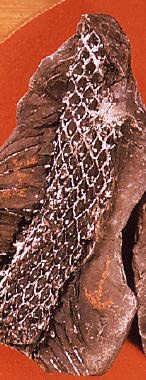








The oldest lycophytes, the Asteroxylales, sometimes called the Drepanophycales, appear in the fossil record in the early Devonian, though fossils of Baragwanathia have been found in the Silurian of Australia. Many of the plants included in this group appear intermediate in form between the zosterophyllophytes and the other lycophytes. For this reason, a few of them are classified in this other group by some paleobotanists.
Herbaceous lycophytes are not common in the fossil record as megafossils, though fossils of several orders are known from the Devonian, and material believed to belong to the extant orders Lycopodiales and Selaginellales have been found in Carboniferous and Jurassic deposits. The spore record, by contrast, is quite good for herbaceous lycophytes.
Though there are only a few well-known herbaceous fossil lycophytes, there are numerous well-preserved specimens of tree-sized species. The Lepidodendrales were a group of arborescent lycophytes which formed forests that dominated major global habitats for 40 million years. During the Mississippian and Pennsylvanian, scale trees over 35 meters tall grew in the vast coal swamps of eastern North America. These plants have made important contributions to coal seams. The most familiar of these are Lepidodendron and Sigillaria. Shown at right is a mold of a Lepidodendralean branch. Such fossils are formed when sediments surround and bury plant material, later to harden and record the shape of the surrounded material.
The grandeur of lycophyte trees came to an end some 296 million years ago, with the Westphalian-Stephanian major extinction event. Only a few taxa survived this; some of these later went extinct while others went on to evolve new forms, but never again did they produce the giant scale trees.


